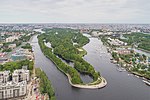Krestovsky Ostrov (Saint Petersburg Metro)
Railway stations in Russia opened in 1999Railway stations located underground in RussiaRussian railway station stubsRussian rapid transit stubsSaint Petersburg Metro stations

Krestovsky Ostrov (Russian: Крестовский остров) is a station on the Frunzensko-Primorskaya Line of Saint Petersburg Metro, opened on September 3, 1999. It should have been opened earlier but the opening was postponed due to delays in the construction of the station lobby. It serves Krestovsky Island and Krestovsky Stadium, home of FC Zenit Saint Petersburg.
Excerpt from the Wikipedia article Krestovsky Ostrov (Saint Petersburg Metro) (License: CC BY-SA 3.0, Authors, Images).Krestovsky Ostrov (Saint Petersburg Metro)
Рюхина улица, Saint Petersburg Ostrova (округ Чкаловское)
Geographical coordinates (GPS) Address Nearby Places Show on map
Geographical coordinates (GPS)
| Latitude | Longitude |
|---|---|
| N 59.971781 ° | E 30.259442 ° |
Address
Рюхина улица 8
197110 Saint Petersburg, Ostrova (округ Чкаловское)
Saint Petersburg, Russia
Open on Google Maps










